It was a crazy ride, but stocks just finished their best week since March.
The S&P 500 initially dropped, continuing a wave of bearishness from October. But it quickly reversed and chalked up a 2.4 percent gain for the period between Friday, October 26, and Friday, November 2. Money continued to shift away from high-profile technology stocks.
Just take Apple (AAPL), which had one of its worst quarters in recent memory. CEO Tim Cook added fuel to the fire, with a declaration he’d no longer provide guidance on smart-phone shipments. Maybe he forgot that no news is seldom good news in the hopeful world of growth investing.
Other headlines gave investors more reason for optimism. Job reports from both ADP and the Labor Department beat estimates, with wages increasing at their quickest rate this decade. Consumer confidence also rose more than expected to a new 18-year high.
That made economically sensitive sectors like materials, financials and small-caps the best performers last week, up 6 percent and 4 percent, respectively. It was a mirror-image of the previous week, when safe-havens outperformed.
There was also plenty of back-and-forth between Washington and Beijing over trade. That may get even more frequent as leaders prepare for the G-20 meeting on November 26.

Technically, the S&P 500 managed to close back above the 2700 area where it bottomed in late June. The tech-heavy Nasdaq-100, on the other hand, failed to regain a potentially key support line around 7000.
Oil had its biggest weekly drop since February as rising inventories and poor economic data in China weighed on sentiment. President Trump also muted the effect of oil sanctions against Iran by reportedly granting waivers to countries like Japan and India.
Oil, oil, and more oil. Is it time to think about airlines and automakers?
Red Hat (RHT) was the single-best performer int he S&P 500 last week, soaring 48 percent after accepting a takeover bid from International Business Machines (IBM). Under Armour (UAA) followed with a 32 percent gain, thanks to blowout results.
Then you have General Electric (GE). No, that wasn’t a piano falling out the window. It was just a former industrial powerhouse crumbling 18 percent into the single digits. Everything that could possibly go wrong — earnings, revenue, accounting — went wrong. FLIR Systems (FLIR) followed with a 13 percent drop.
This week’s agenda is quieter but still has some big events. It starts with the Institute for Supply Management’s service-sector index this morning.
Tomorrow’s mid-term election day in the U.S. CVS Health (CVS) and ELi Lilly (LLY) also report earnings.
Wednesday brings crude-oil inventories, along with results from Square (SQ), Qualcomm (QCOM), Wynn Resorts (WYNN) and Roku (ROKU).
The Federal Reserve concludes a meeting on Thursday, but isn’t expected to announce a change to interest rates. Initial jobless claims and earnings from Walt Disney (DIS) and Activision Blizzard (ATVI) are also due.
Consumer sentiment wraps things up on Friday. Next week may also see buzz around Chinese Internet stocks like Alibaba (BABA) heading into Singles Day on Sunday, November 11.


























